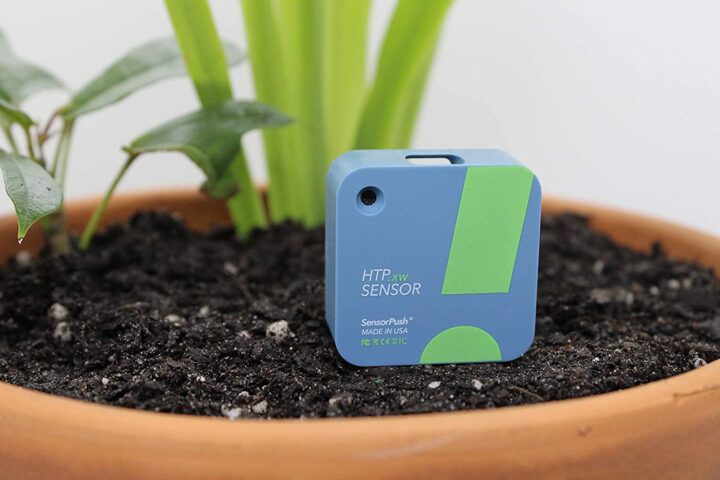A WiFi temperature sensor may be the solution to monitoring specific environmental conditions. While weather stations serve their purpose, sometimes less is more. This guide aims to shed light on the best remote temperature sensors available—some boasting capabilities on par with their more elaborate weather station counterparts.
Imagine tracking temperature and humidity levels in hidden corners of your home, like a basement pantry. Or perhaps you manage a greenhouse and need real-time data to create the perfect ambiance for plant growth. WiFi temperature sensors serve these needs efficiently and often include additional functionalities like atmospheric pressure monitoring.
Position your WiFi temperature sensor virtually anywhere—from attics and basements to greenhouses and garages—to optimize your heating or cooling systems, safeguard against frozen pipes, or maintain an ideal living environment. These wireless devices range from basic temperature-only models to advanced units with robust data collection and analytics tools. With our decade-long expertise in reviewing these gadgets, we’re here to guide you to the market’s most effective, user-friendly remote temperature sensors.
Our Top Picks

This package includes three temperature sensors and a Wi-Fi gateway to allow you to access the sensors. But it does not have the true remote monitoring of the Temp Stick.

While this model does have Wi-Fi and Bluetooth, it only allows you to view data when you're on the same network as the device.

Know conditions anywhere with this easy-to-use, wireless, rugged, waterproof environmental data logger.
You might not need WiFi, though
While connecting to your WiFi temperature sensor from just about anywhere is incredible, it’s not always necessary. Some great options use Bluetooth instead, and you’ll just need to download data from your sensor every so often. Some of these sensors can hold a surprising amount of data.
Remote temperature sensors are fantastic tools, but we’d be trying to sell you something if we said everybody needed one. So we’ll split them between the Wi-Fi (and even cellular connected) and Bluetooth options. If you don’t need any connectivity at all, we even have options there. See below.
Best Remote Temperature Sensors
Govee WiFi Hygrometer Thermometer Sensor 3 Pack
This package includes three temperature sensors and a Wi-Fi gateway to allow you to access the sensors. But it does not have the true remote monitoring of the Temp Stick.
At first glance, the Govee WiFi Hygrometer Thermometer 3-Pack looks like a great deal and is similar to the Temp Stick WiFi temperature sensor. However, there are some critical differences between the Temp Stick or the SensorPush and Govee’s version. While it is Wi-Fi-capable, it only allows you to view data from your sensors while on the same network as the WiFi gateway included in the package.
Like most other WiFi temperature sensors, you cannot view your data over the internet through the app. The battery life of only four months is pretty short among the devices we reviewed for our Best WiFi Temperature Sensor of 2022 rankings. However, you can go wrong at this price. The WiFi gateway can support more than the three sensors it ships with, up to 10 sensors in all, two more than the Ambient Weather WS-10.
- Inexpensive way to monitor multiple locations
- You can add more and view on app
- You can only view your data when you're on the same Wi-Fi network, no remote access
Govee WiFi Thermometer Hygrometer
While this model does have Wi-Fi and Bluetooth, it only allows you to view data when you're on the same network as the device.
The Govee WiFi Thermo-Hygrometer doesn’t require an additional hub, unlike the previous Govee model. But it still suffers from the same lack of remote access as other Govee WiFi temperature sensors. That said, issues like battery life are addressed, and an included lanyard allows you to hang it in the location you want to monitor.
While it might suffer from a few functionality issues, the Govee WiFi Thermo-Hygrometer is our list’s cheapest wireless temperature-sensing device. It overall performs well enough that the lack of remote access isn’t that much of an issue.
- It's cheap
- Need to be on same Wi-Fi network to view data, no remote access
MarCELL Cellular Temperature, Humidity & Power Monitor
The MarCELL combines a remote temperature sensor with cellular data service through Verizon, with plans starting at $8.25 per month.
There are situations where a standard WiFi temperature sensor isn’t going to cut it. For these situations, the MarCELL cellular monitoring system is a perfect solution. While it requires a subscription plan ($8.25/month) for its internet connection, the device has an integrated Verizon cellular modem, allowing you to place the device anywhere there’s a Verizon cellular network signal.
This makes it an excellent solution for an RV, vacation home, or any other remote location where you might not have WiFi network access, a mobile hotspot, or the ability to visit regularly to connect to the sensor.
Remember that you must plug the device into an AC unit to operate (although a backup battery can provide up to 48 hours of power during power outages). While we haven’t had a chance to test out the unit yet, verified reviews are overwhelmingly positive, even with the additional subscription costs necessary to use the device.
- Uses Verizon's 5G network
- Monthly service fee
- Requires AC power for normal operation
Best Temperature Sensors
The HT1 is a small, inexpensive temperature and humidity sensor that fits just about anywhere.
The Temp Stick is a big sensor, so you might have trouble fitting it into tight spaces. For these types of applications, we’d recommend the SensorPush HT1. Measuring a little over 1.5 inches square and less than three-quarters of an inch thick, you can fit this just about anywhere, and it lasts an entire year on a single charge.
SensorPush also offers two higher-end options: the HT.w, which increases battery life to two years and is water resistant, and the HT.xw, which adds barometric pressure and higher-quality instrumentation.
One big drawback to the SensorPush wireless thermometer hygrometer is its data storage capabilities and lack of WiFi connectivity. Unless you purchase the WiFi gateway, you’re limited to connecting to the device via Bluetooth and can’t remotely monitor the sensor. But if these aren’t a concern, you can save quite a bit of money over the Temp Stick by going with the SensorPush instead, whose temperature accuracy rivals the Temp Stick thanks to a Swiss-made sensing component.
- Small, can fit anywhere
- Bluetooth only, Wi-Fi optional
Kestrel Drop D3 Wireless Temperature, Humidity and Pressure Data Logger
Know conditions anywhere with this easy-to-use, wireless, rugged, waterproof environmental data logger.
Kestrel's trademark accuracy now comes in much smaller sizes. The D3, short for the three variables it measures—temperature, humidity, and pressure—can be placed (or hung) just about anywhere. You can monitor temperature, humidity, heat index, dew point temperature, station pressure, density altitude, and pressure trend in any environment, wet or dry.
The Kestrel LiNK app—the same one used for its weather meters—allows you to store thousands of data points and customize logging rate, connections, and temperature alerts. You can also view, save, and share data from multiple DROPs with any Bluetooth-enabled iOS or Android device.
- Accuracy, of course
- Slightly more expensive than similar models from competitors
The HTP.xw adds barometric pressure readings and like the HTP.w is water resistant.
The SensorPush HTP.xw is the company’s top-end model and measures temperature, humidity, and pressure (one of the few WiFi temperature sensors we know that can do that). With higher-quality instrumentation, readings should be more accurate — however, you’ll still need the WiFi gateway to connect your sensor to the internet for remote access.
That puts it in the neighborhood price-wise of the Temp Stick, which we feel is an overall better buy.
- Water-resistant
- Barometric pressure readings
- Compact size
- All those features come at a price
Kestrel Drop D3FW Fire Weather Monitor
This portable data logger seems like a perfect tool for firefighters of all kinds and isn't expensive.
When managing a burn site, knowing environmental conditions are within prescription is important for compliance and to ensure a fire doesn’t get out of control. Gathering sufficient weather data from site visits to decide when to burn can be challenging.
In addition to the full wind and weather readings from a Kestrel weather meter, the new Kestrel DROP data loggers can be left on site recording a history of conditions and trends, which can be viewed on a mobile device and shared via email.
- Small and easy to place
- Live monitoring isn't possible when out of range
Kestrel Drop D2AG Livestock Heat Stress Monitor
This portable monitor informs you of heat conditions in your barn or during transport.
The Kestrel Drop D2AG Livestock Heat Stress Monitor is a very affordable, rugged heat stress monitor used in the barn, during transport, or anywhere livestock are housed. Hang in place wherever insight into conditions is needed, and access current conditions and historical readings with your iOS or Android device.
Kestrel consulted with experts in livestock heat stress to design the D2AG, and the DROP itself can store thousands of data points.
- Perfect for farmers in regions where heat stress can be an issue
- Requires you to be within Bluetooth range for live monitoring
If budget is a big concern for you, look no further than the ThermoPro TP62. It is the cheapest recommendation on our list and gets great reviews, and unlike some cheaper models has a backlit display. While this package includes just a single sensor, you can add up to two more sensors. The console is small and compact. However, it features a large LCD readout, making it easy to view from a distance.
Accuracy suffers a bit and it’s nowhere near as accurate as our other recommendations (accuracy issues were the most common poor review). But if you are looking for a low-cost alternative, this is the most popular and best-reviewed budget WiFi temperature sensor. However, like anything cheap, you do get what you pay for.
Wrapping Up
Remote temperature monitoring is perfect for many situations where a weather station might be more than you need and save you some money. However, don’t just factor price into your buying decisions. Accuracy and expandability are far more critical factors. In the long run, you’ll be much happier with your purchase if you use these as your primary factors in choosing a WiFi temperature sensor.









